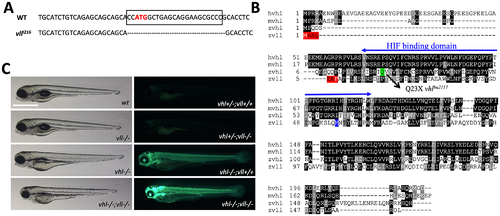
Figure 1: A vll mutant allele, vll216, is generated by a zinc finger nuclease. (A) The mutant allele harbors 23 nucleotide deletion around translational starting site. (B) Zebrafish Vll shares 52% homology with human VHL. The seven amino acids that are lost in vll216 are highlighted in red. Even if the next available ATG (highlighted in blue) were to be used as an alternative translational start site, it would lead to a protein that lacks most of the predicted Hif binding domain. (C) Since phd3 (egln3) expression most dramatically reflects the increased Hif expression, we used Tg (phd3:: EGFP)i144 transgenic line as a Hif signaling readout. Zebrafish vll–/– embryos do not show any morphological phenotype and the Tg (phd3:: EGFP)i144 expression in the mutants was identical to that in the wild type embryos. Reflecting the role of Vll in Hif regulation in the absence of Vhl, there was an enhanced GFP expression in the vhl–/–; vll–/– double mutant embryos in comparison to that in vhl–/– embryos. Scale bar: 1 mm.
|

